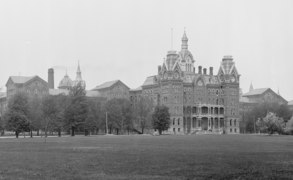| Columbus State Hospital | |
|---|---|
 20th century aerial view of the hospital | |
 | |
| Geography | |
| Location | 1960 West Broad St., Columbus, Ohio, United States |
| Coordinates | 39°57′30″N83°3′20″W / 39.95833°N 83.05556°W |
| Organization | |
| Funding | Public hospital |
| Type | Specialist |
| Services | |
| Speciality | Psychiatric hospital |
| History | |
| Opened | 1838 |
| Closed | late 1980s |
| Links | |
| Lists | Hospitals in Ohio |
Central Ohio Lunatic Asylum | |
| NRHP reference No. | 86000851 |
| Added to NRHP | April 24, 1986 |
Columbus State Hospital, also known as the Ohio State Hospital for the Insane, was a public psychiatric hospital in Columbus, Ohio, founded in 1838 and rebuilt in 1877. [1] The hospital was constructed under the Kirkbride Plan. [2]
Contents
The building was said to have been the largest in the U.S. or the world, until the Pentagon was completed in 1943. [3] [4]





